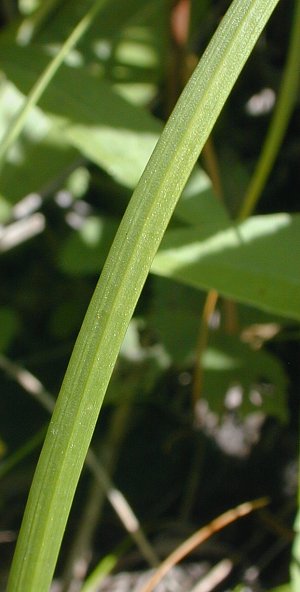Description: This perennial plant consists of a rosette of basal leaves that are about 6-12" long and 2-3 mm. across. These erect to semi-erect leaves are linear, flat, and often slightly arching; they are medium green and glabrous. Each leaf has a poorly defined keel along its midvein, while its margins are smooth. Occasionally, flowering stalks emerge from the ground that are about the same height as the leaves, or slightly higher. These stalks are terete (round in cross-section), rather than flat, and they are held stiffly erect. Each stalk terminates in an inflorescence that has a sack-like covering spanning about ¾" across. This sack-like covering is white-membranous and ovoid in shape, tapering into a long beak at its apex. This covering splits open and withers away to reveal an umbel of about 6-12 pedicellate flowers or a similar number of sessile bulblets (frequently some combination of both).

The star-shaped
flowers are about ½" across. Each flower has 6 tepals, 6
stamens, and a light green ovary with a style. The tepals are
lanceolate to elliptic in shape and white, light
pink, or pink. The bulblets are about ¼" long, ovoid in shape, and
light green to
pinkish red. Wild Garlic is especially likely to flower or have reddish
bulblets in a sunny situation. The pedicels of the flowers are about ¾"
long, medium green, glabrous, and terete. The blooming period occurs
during early
summer and lasts about 3-4 weeks. There is no noticeable floral scent,
although the
foliage exudes a typical onion scent. After the blooming period, the
flowers are replaced by seed capsules; each capsule contains several
small dark seeds.
The root system consists of a
bulb with thick fibrous roots, from which offsets may occasionally
develop. This plant can also reproduce by its seeds and/or aerial
bulblets.
 Cultivation:
The preference is full sun or partial sun, moist to mesic
conditions, and a fertile loam.
This plant also grows in light shade in wooded areas, but it is less
likely to flower (instead, only aerial bulblets are produced). While
growth is best in a fertile
loam, other
kinds of soil are tolerated. Periods of dry weather are also tolerated.
While Wild Garlic spreads readily by means of offsets and bulblets, it
often
fails to produce viable seeds. This is one of the first plants to
develop leaves during the spring.
Cultivation:
The preference is full sun or partial sun, moist to mesic
conditions, and a fertile loam.
This plant also grows in light shade in wooded areas, but it is less
likely to flower (instead, only aerial bulblets are produced). While
growth is best in a fertile
loam, other
kinds of soil are tolerated. Periods of dry weather are also tolerated.
While Wild Garlic spreads readily by means of offsets and bulblets, it
often
fails to produce viable seeds. This is one of the first plants to
develop leaves during the spring.
Range & Habitat:
Wild Garlic occurs in every county of Illinois, where it is native
and quite common. Habitats include moist to mesic black soil
prairies, upland and floodplain woodlands, moist meadows near rivers
and woodlands, thickets, banks of streams, thinly wooded bluffs,
abandoned fields, pastures, areas along railroads, roadsides, and waste
areas. Wild Garlic has low fidelity to
any particular habitat; it is often observed in degraded prairies and
woodlands. This plant doesn't compete well against taller forbs, such
as Canada Goldenrod (Solidago canadensis),
preferring areas with less ground cover.
Faunal Associations:
The nectar and pollen of the flowers attract the Onion Bee (Heriades carinatum),
mason bees (Hoplitis spp.),
Stelid bees (Stelis spp.),
Halictid bees (Lasioglossum
spp.), plasterer bees (Colletes
spp.), masked bees (Hylaeus
spp.), Syrphid flies, bee flies (Bombylius spp.),
and wasps. Other insects suck plant juices, feed on bulbs, and other
parts of Wild Garlic and other
Allium spp. These species include the
Green Stink Bug (Acrosternum
hilaris), the Onion Plant Bug (Lindbergocapsus allii),
larvae of the False Japanese Beetle (Strigoderma arbicola),
the Onion Maggot (Delia
antiqua), larvae of the Black Onion Fly (Tritoxa flava),
larvae of the Onion Bulb Fly (Eumerus
strigatus), and
Onion Thrips (Thrips
tabaci).
During the early spring when little else is green, the vernal basal
leaves of Wild Garlic are occasionally browsed by White-tailed Deer
(personal observation). Other hoofed mammalian herbivores, such as
cattle, will consume Wild Garlic along with grass and other plants.
This can cause the milk of such animals to have an
off-flavor. Rabbits avoid consumption of this plant because they appear
to dislike
the onion scent and spicy taste of the foliage. The foliage and bulbs
are edible to humans, although the consumption of large amounts may be
slightly toxic.
Photographic Location:
The photographs were taken at Red Bison Railroad Prairie in Savoy,
Illinois.

Comments: This is the most common species of native onion (Allium sp.) in Illinois. Wild Garlic (Allium canadense) can be readily distinguished from other native onions, such as the Cliff Onion (Allium stellatum) and Nodding Onion (Allium cernuum), by the presence of aerial bulblets in its inflorescence. An introduced onion in Illinois, Field Garlic (Allium vineale), also produces such bulblets. However, the leaves of Field Garlic are elliptic in cross-section with a hollow interior (at least at their bases), while Wild Garlic has leaves that are flat and solid throughout. There is a variety of the Wild Garlic (Allium canadense var. mobilense) that produces only flowers, rather than bulblets and flowers, or only bulblets. However, it is less common than the typical variety, as shown in the photographs.